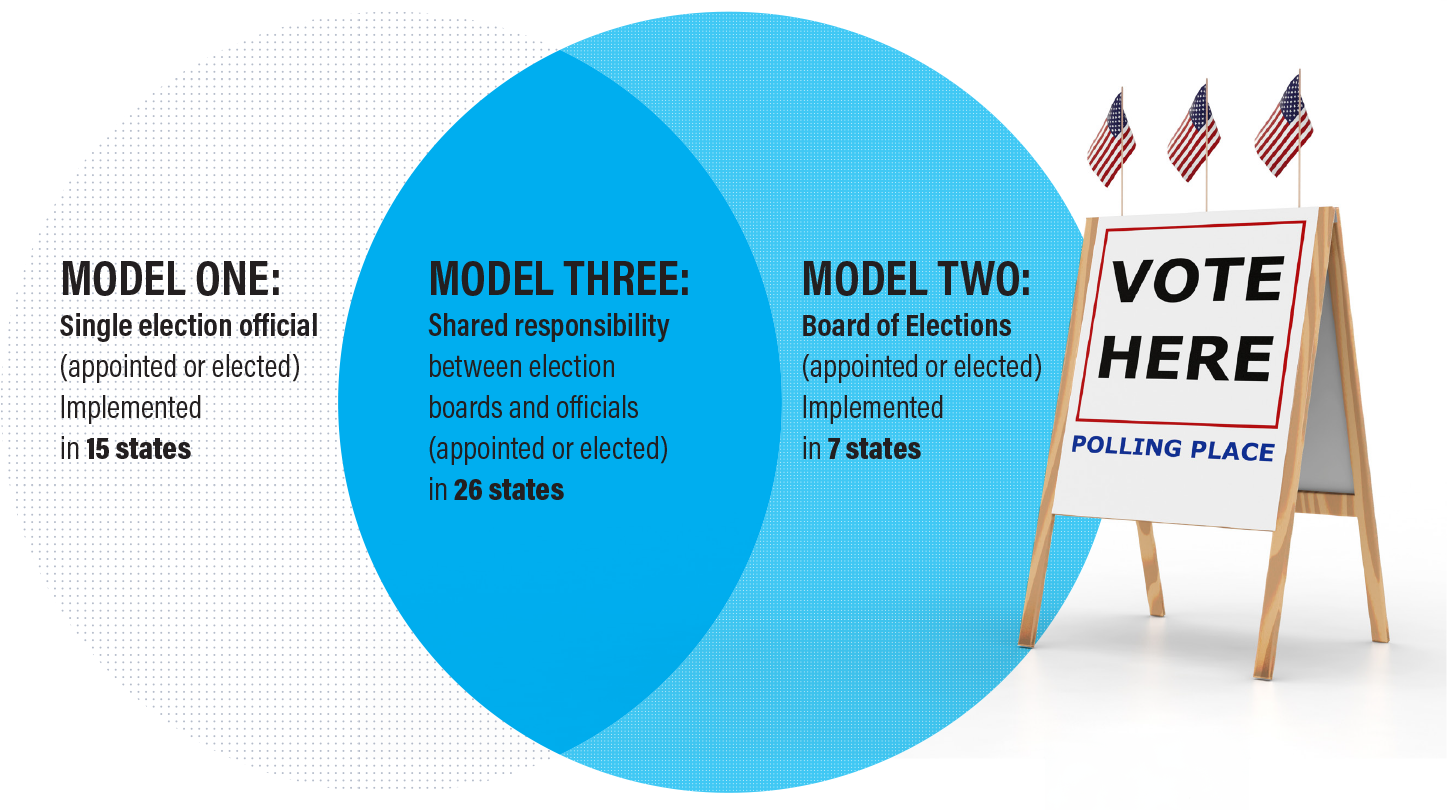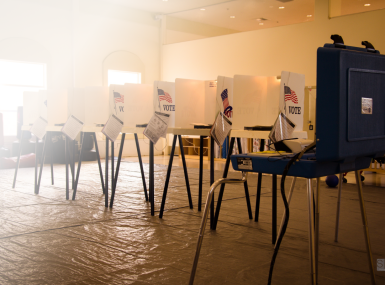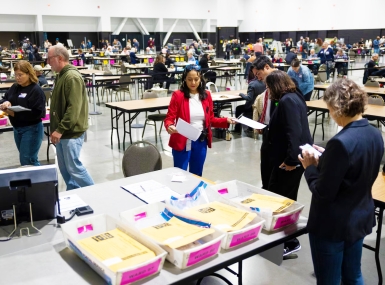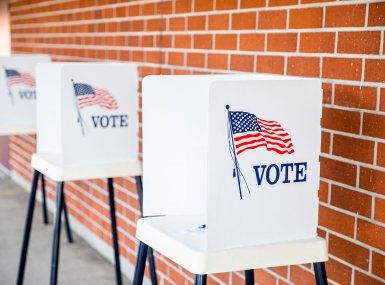America’s County Governments: A Primer on County-Level Election Administration

Upcoming Events
Related News
This research brief highlights the county role in administering elections. It discusses the scope of responsibilities, variations in local election systems and canvassing procedures, and funding for election costs.
Jump to Section
Counties are Central to Our Nation's Elections
The United States has a decentralized system of election administration, where states and local governments share the responsibility of overseeing election administration.[1] The organization of local election systems can vary such that states allow several local offices or authorities to supervise election administration.[2] In certain states, election administration responsibilities are divided between a local election official, who may be elected or appointed, and a board or commission of elections.[3]
County governments play a crucial role in upholding our nation’s democracy by administering and overseeing most local, state and federal elections.[4] This includes managing voter registration, coordinating poll workers and managing polling places. During each election cycle, counties oversee over 100,000 polling places and manage over 630,000 poll workers.[5] More than 200 million people typically register and are eligible to vote in jurisdictions where counties play a significant role in election administration.[6]
This research brief highlights the county role in administering elections. It discusses the scope of responsibilities, variations in local election systems and canvassing procedures, and funding for election costs.
Note: In this brief, “county (or local) election board” refers to a board or commission of elections and combined board of elections and registration where applicable.
Local Election Systems Are Critical to Our National Election Structure
The decentralized nature of election administration in the United States includes shared responsibility between state and local governments.[7] State legislatures regulate election policies and laws, determining how elections are administered across the state. The result is a mosaic of different structures of local election systems between and within states, with counties primarily responsible for implementing elections.
Election oversight is primarily the responsibility of county governments in 36 states.[8] There are few exceptions to county-managed elections, like Alaska, where the state oversees the administration, and Delaware, where elections are highly centralized and state-managed despite being implemented at the county level.[9]
Election administration encompasses policymaking, managing, planning and ultimately executing election laws. The significance of the county’s role in election administration is best recognized by understanding the various components of the election process, which typically consists of three main activities: (1) voter registration,[10] (2) vote casting and (3) counting.
Within these three main activities, counties perform a wide variety of election administration duties, including maintaining voter registration rolls; designing and printing ballots; recruiting and training poll workers; selecting and preparing polling places; preparing and testing voting equipment; informing residents of voting modes, candidates and ballot measures; and counting and certifying votes.
Figure 1: Election Administration, by Level of Government
Counties oversee election administration in most states
The Decentralized Nature of U.S. Elections Is Demonstrated Within Various Local Election Administration Structures
Local governments typically administer elections through one of three models: (1) the single election official model, (2) the local board of elections model or (3) a hybrid model that shares responsibilities between an official and a local election board. These models illustrate the decentralized and complex nature of the United States election administration system, which varies significantly across local jurisdictions within and across states. The diverse approaches to election administration underscore the interplay between state laws, local needs and the structure of electoral authority.
Figure 2: Local Election Administration Models
Exploring the Relationship and Distinctions Among Local Election Administration Models

Model One
A Single Local Election Official
In the single-election official model, election administration activities are exclusively managed by a single individual appointed by the state or county or elected by residents to the office.[11] Fifteen (15) states have adopted this model.[12] Unlike other states, no local boards of elections exist within these jurisdictions, positioning these individuals as the county's primary election authority. This system is not without its exceptions: Hawaii, Illinois and Wisconsin diverge from the norm in unique ways.[13]
In Hawaii, election management involves County Clerks who, though appointed by the county, work collaboratively with the state to oversee voter registration and election execution.[14] This partnership model contrasts with the more centralized models seen elsewhere.
Illinois offers another variation. While county clerks serve as the chief local election officials across most local jurisdictions, the state's legal framework permits cities and counties to opt out of the clerk system to establish their own board of election commissioners.[15] This board then assumes responsibility for election administration. The creation of a county board of election commissioners is further made possible through county ordinance or a direct vote by the county's registered voters.[16]
Wisconsin has a unique election administration model that involves town, village, city and county clerks.[17] State law stipulates that larger cities and counties, with populations exceeding 500,000 and 750,000, respectively— establish a three-member board of election commissioners to oversee elections.[18] This approach, diverging from the traditional clerk-based administration, applies exclusively to the City of Milwaukee and Milwaukee County.[19]
Model Two
A Local Board of Elections
Under the local board of elections model, a county board primarily manages the day-to-day implementation of election administration policy. These boards can also serve as the local board of canvassers to process, evaluate and report election results. Appointments to the local election boards are made at the state or local level or a combination of the two, with input from the county legislative body, the governor or the state's chief election official.
County election boards manage election activities in seven states: Maryland, New York, North Carolina, Ohio, Pennsylvania, South Carolina and Tennessee.[20]
In these states, the election boards serve as the chief county election authority, though they can appoint other local election officials and staff to support their work. In five of those states, the county board of elections is a state-appointed entity, while in New York, election commissioners are appointed by the county legislative body.[21] Pennsylvania is the only state in this category where the county legislative body serves as the county board of elections.
Model Three
Shared Responsibility Between Local Election Boards and Officials
The hybrid model involves two or more individuals and a local board of elections managing election operations. Twenty-six (26) states implement this model. The board consists of three to five members, including a local elected official, a County Clerk or County Auditor and a representative from each major political party within the jurisdiction. These parties are responsible for election conduct, voter registration and absentee balloting procedures.[22]
In Arkansas, for example, County Clerks oversee voter registration and absentee voting, while a three-member county board of election commissioners, supported by poll workers and election judges, manages all other election administration aspects. In Louisiana, election administration duties are shared among various local entities and individuals. One of these entities is the board of election supervisors, a statutorily created body comprising the registrar of voters, the Clerk of Court and the chairman of the parish executive committee of each recognized political party and their alternates. The Clerk is the chief local election officer, managing elections, equipment and personnel. Each parish has a registrar of voters for voter registration and a board of election supervisors to supervise election preparation and conduct.
In some states, the election boards operate at different local government levels, assigning each government entity election administration responsibilities accordingly. In Minnesota, for example, state law provides for decentralized management of elections where County auditors, municipal clerks and election officials, appointed by the governing body of each county, city or town, manage election administration. Counties are responsible for providing standardized election services, such as voter registration, ballot programming and the purchase of voting equipment for county-wide use. Conversely, cities are responsible for providing specialized election services to their citizens, such as language support to voters.
Each county, city and town in Michigan is responsible for election administration at the local level. County, city and township clerks each maintain voter registration records and supervise operations at polling places, while a three-member election commission and a four-member board of canvassers organize precincts, appoint poll workers and oversee post-election canvassing of election results, respectively.[23]
Even at a given local government level, election administration duties are further distributed among two or more individuals or entities. In 13 states, the responsibility of election administration is shared between two or more officials. Arizona illustrates this characteristic well by allocating election duties among the County Recorder, the County Election Director and the County Board of Supervisors.[24]
Election officials and boards can either be elected or appointed. Mississippi is the sole exception by having a locally elected individual and board responsible for overseeing election administration. In Mississippi, the Clerk of the Circuit Court acts as the County Registrar in each county, while local election boards, composed of five county election commissioners—one elected from each supervisor's district—handle all aspects of elections within a county. [25] These boards operate at the municipal level, varying their size according to the municipality's population.
Figure 3: Breakdown of Local Election Administration Structures by State
In the majority of states (26), election administration responsibilities are shared between a local official and a local election board
Exploring the Variation in Election Administration Structures Within States
Within most states, election administration structures are uniform across local jurisdictions, from the individual or local body overseeing elections to the procedures for verifying votes. Where we find variation within states, differences can be attributed to jurisdiction size (population level or density) and the level of authority given to counties under state law to determine local affairs and government operations.
Jurisdiction Size Affects Local Election Administration Structures
An integral aspect of local election administration is the size of the jurisdiction, which can impact voter experience and how elections are managed. Over 10,000 jurisdictions nationwide are responsible for administering elections, with the majority at the county and municipal levels.[26] These local jurisdictions vary dramatically in size, ranging from fewer than 100 voters to over 1 million voters.
In smaller jurisdictions, the chief local election official often holds an elected position, such as a County Clerk, Recorder, Registrar or Auditor. In some cases, state law allows larger jurisdictions to have differing election administration structures, with larger jurisdictions being granted authority to establish their own administrative county body to oversee election administration.
In Indiana, for example, state statute allows for a combined county board of election and board of registration with joint voter registration duties and management of the election process for jurisdictions having a population of more than 400,000 but less than 700,000 residents.[27] Another example is Kansas, where state law allows counties with a population of over 130,000 to establish an office of the commissioner of elections, administered by an election commissioner appointed by the secretary of state.[28] The state's four largest counties - Johnson, Sedgwick, Shawnee and Wyandotte – have an appointed election commissioner to administer elections; in the other 101 counties, it is the County Clerk.
New Jersey also has a system where election administration structures at the county level differ based on population size. Each county possesses an elected County Clerk and an appointed Board of Elections responsible for supervising elections. In counties of specific classes, a state-appointed superintendent of elections oversees election operations and serves as the county Commissioner of Registration.[i] The Board of Elections assumes this role in counties without a superintendent.
A Look at State Laws and Variations in Election Administration
The conduct of local elections can vary based on the state-granted authority to counties. This authority also shapes how counties structure operations. Localities can adopt home rule charters, allowing greater flexibility over local affairs, government structures and service provision models. These charters, however, must be consistent with state law.
Pennsylvania law, for example, establishes a board of elections in each county consisting of county commissioners to oversee elections. In counties classified as first-class or counties that have adopted home rule charters or optional plans, the board of elections can consist of registered voters appointed by the county legislative body. For example, the Home Rule Charter for Luzerne County, Pennsylvania, establishes that the Board of Elections and Registration comprises five registered voters appointed by the County Council.[29]
In Washington, King County is the only locality with a separately elected position of County Director of Elections charged with overseeing elections at the county level. Even though the chief local election official in most county jurisdictions in Washington is the County Auditor, King County can have this elected nonpartisan position because of the adopted home rule charter.
Florida law also allows counties to adopt a home rule charter. Miami-Dade County is a charter county with a structure consisting of an appointed Supervisor of Elections. In most counties in the state, this position is one of five county-wide elected constitutional officers.
[i] In New Jersey, the election administration at the county level is divided into different structures based on population. Each county in New Jersey has an elected County Clerk and an appointed Board of Elections responsible for supervising elections. State law specifies that in counties classified as first class, second class and fifth class (which add up to 9 counties), a superintendent of elections is appointed to supervise elections in the county.
County Election Officials Ensure the Integrity of Election Results Through Canvassing Procedures
The county plays an important role in the election process even after the polling places have closed. County election officials work to count, canvass and certify election results.[30] The canvassing process is a coordinated effort among local and state election officials. They ensure that ballots cast, be it in-person, absentee, provisional, challenged or by uniformed and overseas citizens absentee voting, are accounted for and included in the final results. After the county canvass, election results are transmitted to the office of the state's chief election official for review by a state canvassing board that certifies the results.
Canvassing procedures vary across states, with several local officials or offices handling voter registration and Election Day activities and overseeing the nuts and bolts. Some states require counties to establish a county canvassing board of elected county officials to review ballots and certify results. For instance, in Minnesota and Florida, state statute requires a county canvassing board in each county.[31] In Minnesota, county canvassing boards consist of five members: county board members, elected constitutional officers such as the county auditor and the district court administrator, and the mayor or chair of the town board of the most populous municipality in the county. In Florida, the county canvassing board comprises three members: the chair of the board of county commissioners, the supervisor of elections and a county court judge who acts as chair of the canvassing board. In Kansas, Montana, and New Mexico, the county canvassing board consists of the elected governing body charged with ruling on all provisional ballots and certifying the election results within the county.[32]
In Nebraska, the county canvassing boards can comprise appointed registered voters within the county's jurisdiction.[33] Maryland and Ohio require each county to establish a county election board to oversee election administration. These boards are also charged with serving as the local board of canvassers and certifying the results of each election.[34] In states where the election administration responsibilities run through the municipal level, such as Michigan, Minnesota and Wisconsin, each local electoral body has a board of canvassers responsible for post-election canvassing of election results.
Counties, States and Municipalities Share the Financial Responsibility for Administering Elections
Understanding the Financial Dynamics of Election Administration in the United States
In most states, county governments primarily run elections, with the financial responsibility shared among states, counties and municipalities to varying degrees. States reimburse counties and other local governments for some election costs. County governments and other political subdivisions finance election-related duties and responsibilities using general funds. The federal government has contributed by authorizing three significant funding infusions in the last two decades to support state and local government election administration.
The first round of federal funding came from the Help America Vote Act of 2002 (HAVA) due to election administration issues identified during the 2000 general elections.[35] HAVA authorized $3.65 billion to fund reforms in several critical areas of the nation's election administration process. Requirements included replacing voting systems, new procedures for provisional voting, and establishing the Election Assistance Commission (EAC) to distribute HAVA funds to the states and assist with HAVA compliance.
The EAC appropriated the second round of federal funding under election security grants in 2018. This funding went to state and local governments to improve election security, with a focus on cybersecurity. The CARES Act in 2020 provided a recent source of funding, offering $400 million in grants to support state and local governments in administering elections amid the COVID-19 pandemic.
The associated costs with conducting and administering elections include Election Day expenses and the cost of preparing for the next elections. One distinguishing factor to consider when discussing election funding is the difference between the cost of an election and the cost of election administration (or the cost of elections). The cost of an election includes recruiting and training personnel and acquiring the equipment and supplies needed to conduct each election.[36] The cost of elections broadly includes the administrative costs of maintaining the election infrastructure and preparing for future elections.[37] Administrative costs include maintaining voter registration records, testing and securing voting equipment, and maintaining and securing computer systems that manage districting and election night reporting of results.[38]
In the years since the passage of HAVA, the cost of administering elections has risen steeply due to the implementation of voter registration and ballot-casting reforms.[39] It is difficult to ascertain the cost of running elections due to the highly decentralized nature of election administration, the differences in election responsibilities across and within states and the varying ways election activities are reported in government budgets across states, but estimates range from $1 billion to $2.6 billion.[40]
Who Pays for Elections?
The allocation of election-related expenses in the United States depends on the administrative structure within each state and local jurisdiction. State governments play a centralized role in election administration in Alaska and Delaware, making the total cost of elections the state’s responsibility. Municipalities and townships also administer elections in New England and Midwestern states, leading to varying fiscal responsibilities for certain election-related costs. Sometimes, counties cover the initial bill for an election, and other political subdivisions reimburse the counties.
Counties often pay for elections involving county-level offices or positions, while states cover election costs for state and federal races. In Hawaii, counties pay the costs for elections involving county offices, with the state handling expenses for state office elections. Sometimes, states cover or reimburse counties for the costs of elections involving state or federal offices and special statewide elections, such as constitutional amendments or public measures. In Florida, for example, whenever any special or primary election is held, the state must reimburse the county for expenses incurred to conduct any special primary or special election.
County governments also often administer elections for other political subdivisions such as cities, townships, special districts and school districts. In these cases, the municipalities, township governments or other political subdivisions typically reimburse the counties for the expenses of the elections for their offices.
Alternatively, counties require these smaller political subdivisions to pay a portion of the costs of their elections that the county helps administer. For example, in Wyoming, counties typically cover election expenses, while other political subdivisions either pay the actual costs of the election or an equitably proportioned share as determined by the county clerk. In Tennessee, municipalities are responsible for expenses the county election commission incurs in holding municipal elections, including additional expenses when municipal elections coincide with a countywide election day.
Figure 4: Coverage of Election Administration Costs by Level of Government
Counties share the costs for administering elections in most states
Appendix
Who are county election authorities?
The chief county election authority varies from state to state and can be an individual or an entity. The election authority is typically an elected or appointed constitutional row officer such as a County Clerk. In other cases, the chief county election official is the County Registrar, Recorder, Auditor, Superintendent of Elections, Commissioner of Registration and Election Officer or Director, among many others.
There are five states, i.e., Alaska, Delaware, Hawaii, Oklahoma and Virginia, where the election official is a separately appointed position by the county or state elections divisions. For example, in Alaska and Delaware, where elections are mainly state-managed, the state board or division of elections appoints an individual (an Election Director in Alaska and a County Director of Elections in Delaware) in each county or borough to coordinate state responsibilities of elections.
In Oklahoma, though elections are run at the local level primarily by a county election board, the secretary of the county election board has election administration duties. The state election board appoints this official, who serves as the administrative officer of the county election board and has general supervisory authority over all precinct officials and absentee voting board members within the county.
In each county and city in Virginia, a three-member Electoral Board is responsible for conducting all elections. The electoral board appoints a General Register or Director of Elections to oversee all aspects of voter registration and other election administration duties.
Table 1: Chief Local Election Authorities By State
Authors & Acknologedgements
This brief was written and compiled by Stacy Nakintu with support from Jonathan Harris, Ricardo Aguilar and Teryn Zmuda.
Contacts

Stacy Nakintu

Teryn Zmuda
Endnotes
[1] In New Jersey, the election administration at the county level is divided into different structures based on population. Each county in New Jersey has an elected County Clerk and an appointed Board of Elections responsible for supervising elections. State law specifies that in counties classified as first class, second class and fifth class (which add up to 9 counties), a superintendent of elections is appointed to supervise elections in the county.
[1] States have more oversight over policymaking and certain types of elections, while local governments, particularly counties, oversee the implementation of elections at the local level. See Karen L. Shanton, “The State and Local Role in Election Administration: Duties and Structures,” Congressional Research Service, available at: https://www.everycrsreport.com/files/20190304_R45549_24cb977993f4f4b2a1a7fbd7a3e2ba0e32aafbf6.pdf (March 4, 2019).
[2] NACo Research and Governance Project, 2022.
[3] NACo Research and Governance Project, 2022.
[4] Municipalities administer elections in states with town and township governments, like those found in New England, Mid-Atlantic, and Midwestern states. See Karen L. Shanton, “The State and Local Role in Election Administration: Duties and Structures,” Congressional Research Service, available at: https://www.everycrsreport.com/files/20190304_R45549_24cb977993f4f4b2a1a7fbd7a3e2ba0e32aafbf6.pdf (March 4, 2019); and Paige Mellerio, “The County Role in Elections: How Counties Administer Secure and Accurate Elections,” National Association of Counties (NACo), available at https://www.naco.org/resources/county-role-elections-how-counties-administer-secure-and-accurate-elections (November 8, 2022).
[5] National Association of Counties (NACo), “The County Landscape,” Available at: https://www.naco.org/resources/county-landscape (February 13, 2024).
[6] NACo Analysis of State Board of Elections website data, 2022.
[7] The American election system is not centralized, which means that localities have the flexibility to run elections if they meet federal requirements.
[8] NACo Research and Governance Project, 2022.
[9] See Alaska Division of Elections, “City and Borough Elections,” Available at https://www.elections.alaska.gov/Core/cityandboroughelections.php (December 20, 2022). Delaware previously had a board of election in each county charged with administering elections. However, a state department of elections was established with the powers and duties previously vested in the respective county departments of elections. Additionally, the state established a state board of elections with powers and duties previously vested in the various county boards of elections. See Delaware Code Revisors, “Title 15 Elections,” Available at https://delcode.delaware.gov/title15/title15.pdf (December 20, 2022).
[10] Voter registration is the basis for election administration as it impacts planning and implementation. One exception to the typical election process is North Dakota, the only state without voter registration. North Dakota abolished voter registration in 1951, though state law still allows cities to register voters for city elections. See North Dakota Secretary of State, “North Dakota…. The Only State Without Voter Registration,” Available at: https://vip.sos.nd.gov/pdfs/Portals/votereg.pdf (December 19, 2022).
[11] These individuals oversee elections. The person can already be elected to another position (e.g., a county clerk or other row officer who also oversees elections), they can also be elected separately to oversee elections or appointed separately for that purpose.
[12] NACo Research and Governance Project, 2022.
[13] NACo Research and Governance Project, 2022.
[14] State of Hawaii Office of Elections, “Elections in Hawaii,” Available at https://elections.hawaii.gov/elections-in-hawaii/ (December 20, 2022).
[15] In Illinois, elections are administered locally by 108 election authorities, including the county clerks in 101 counties, one county election commission and six municipal election commissions. Currently, only Peoria County has a county election commission, and Illinois law allows cities and counties to opt out of the county clerk system. Six cities, Chicago, Bloomington, Danville, East St. Louis, Galesburg, and Rockford opted out and established a board of three election commissioners appointed by the circuit court. See Illinois State Board of Elections, “Election Authorities,” Available at https://www.elections.il.gov/electionoperations/electionauthorities.aspx (December 20, 2022); and Massachusetts Institute of Technology Election Data + Science Lab, “Illinois' Election Landscape,” Available at: https://electionlab.mit.edu/landscapes/illinois (November 28, 2022).
[16] State law allows any county in which there is no municipal board of election commissioners to establish a county board of election commissioners either by county ordinance or by a vote of the registered residents.
[17] Wisconsin Elections Commission, “About the WEC,” Available at: https://elections.wi.gov/about-the-wec (November 21, 2022)
[18] See Wisconsin State Legislature, “Chapter 7 – Election Officials; Boards; Selection and Duties; Canvassing” Available at https://docs.legis.wisconsin.gov/statutes/statutes/7/i/23 (December 21, 2022); Massachusetts Institute of Technology Election Data + Science Lab, “Wisconsin’s Election Landscape,” Available at: https://electionlab.mit.edu/landscapes/wisconsin (November 28, 2022); and Wisconsin Legislative Council Information Memorandum, “Administration of Elections: Elections Commission and Local Governments,” Available at: https://docs.legis.wisconsin.gov/misc/lc/information_memos/2018/im_2018_12 (November 28, 2022)
[19] Ibid.
[20] NACo Research and Governance Project, 2022.
[21] In New York, election commissioners are appointed by the county legislative body or, in the city of New York, by the city council. Michigan Secretary of State, “State of New York 2024 Election Law,” Available at: https://elections.ny.gov/system/files/documents/2024/04/508_ny-election-law-2024-edition_0.pdf (August 16, 2024).
[22] NACo Research and Governance Project, 2022.
[23] Michigan Secretary of State, “Michigan's Elections System Structure Overview,” Available at: https://www.michigan.gov/sos/elections/upcoming-election-information/voters/special-topics/michigans-elections-system-structure-overview (November 28, 2022); Michigan Bureau of Elections, “Structure of Michigan's Elections System,” Available at: https://www.michigan.gov/-/media/Project/Websites/sos/01mcalpine/I_Structure_of_MI_Elections_System.pdf?rev=8ade2e2574f140debc8c28af9ca878dc (November 28, 2022).
[24] The County Recorder in Arizona manages election duties, including overseeing voter registration and early voting. The County Election Director in Arizona is responsible for conducting elections on Election Day and ensuring ballot tabulation. The County Board of Supervisors in Arizona has specific election-related responsibilities, such as determining polling places for Election Day, emergency early voting locations, and certifying the official election results for the county. See Clean Elections Commission, “How Elections Work” Available at https://www.azcleanelections.gov/election-security/how-elections-work (December 21, 2022).
[25] 2020 Mississippi Election Code, “Title 23. Elections, Chapter 15, Article 7. County registrar shall be circuit court clerk unless found improper; appointment of deputy registrars; liability of registrar for malfeasance or nonfeasance of deputy registrar; computer skills training course.” Available at https://law.justia.com/codes/mississippi/2017/title-23/chapter-15/article-7/section-23-15-223/ (November 22, 2022). 2020 Mississippi Election Code, “Title 23. Elections, Chapter 15, Article 6. Election of county election commissioners.” Available at https://law.justia.com/codes/mississippi/2017/title-23/chapter-15/article-7/section-23-15-213/ (November 22, 2022).
[26] Government Accountability Office (GAO), “2020 Elections: State and Local Perspectives on Election Administration during the COVID-19 Pandemic,” available at https://www.gao.gov/products/gao-22-104731 (October 24, 2022).
[27] 2012 Indiana Code, “Title 3. Elections Article 6. Political Party and Election Officers Chapter 5.2. Combined County Election Board and Board of Registration.” Available at https://law.justia.com/codes/indiana/2012/title3/article6/chapter5-2/ (November 22, 2022).
[28] 2012 Kansas Statutes, “Chapter 19 Article 34 – Election Commissioners.” Available at http://www.kslegislature.org/li_2012/b2011_12/statute/019_000_0000_chapter/019_034_0000_article/019_034_0019_section/019_034_0019_k/ (December 21, 2022).
[29] See Luzerne County Board of Elections & Registration, “Board Overview.” Available at https://www.luzernecounty.org/1082/Board-of-Elections-and-Registration (December 26, 2022)
[30] Shanton, Karen L., “The State and Local Role in Election Administration: Duties and Structures,” Congressional Research Service, available at https://sgp.fas.org/crs/misc/R45549.pdf (October 24, 2022).
[31] See The 2022 Florida State Statutes, “Title IX Electors and Elections: Chapter 102 - Conducting Elections And Ascertaining The Results.” Available at http://leg.state.fl.us/Statutes/index.cfm?App_mode=Display_Statute&Search_String=&URL=0100-0199/0102/Sections/0102.141.html (December 26, 2022); House Research, “Canvassing Boards.” Available at https://www.house.leg.state.mn.us/hrd/issinfo/CanvasBoards.pdf (December 26, 2022).
[32] See Montana Code Annotated 2021, “Title 13. Elections Chapter 15. Canvassing, Returns, And Certificates Part 4. County Canvass.” Available at https://leg.mt.gov/bills/mca/title_0130/chapter_0150/part_0040/section_0010/0130-0150-0040-0010.html (December 26, 2022); New Mexico Statutes Annotated 1978, “Chapter 1: The Election Code.” Available at https://nmml.org/wp-content/uploads/2011/08/2019-Election-Code-Searchable-PDF-by-NM-Clerks-v1.pdf (December 26, 2022).
[33] Nebraska Revised Statute, “32-1028. County canvassing board; appointment.” Available at https://nebraskalegislature.gov/laws/statutes.php?statute=32-1028 (December 26, 2022).
[34] See 2013 Maryland Code Election Law, “Powers and duties.” Available at https://law.justia.com/codes/maryland/2013/article-gel/section-2-202/ (December 26, 2022); See Ohio Revised Code, “Title 35 – Elections | Section 3501.11 | Board duties.” Available at https://codes.ohio.gov/ohio-revised-code/section-3501.11 (December 26, 2022)
[35] Shanton, Karen L., “The State and Local Role in Election Administration: Duties and Structures,” Congressional Research Service, available at https://sgp.fas.org/crs/misc/R45549.pdf (October 24, 2022).
[36] Stewart III, Charles, “The Cost of Conducting Elections,” National Institute for Civil Discourse, available at https://electionlab.mit.edu/sites/default/files/2022-05/TheCostofConductingElections-2022.pdf (November 8, 2022).
[37] Ibid.
[38] Ibid.
[39] Kimball, David C., & Baybeck, Brady, “Are All Jurisdictions Equal? Size Disparity in Election Administration, available at http://www.umsl.edu/~kimballd/DKBBELJ2013.pdf (October 24, 2022).
[40] Additionally, any available data on the costs of elections would be severely limited regarding comparability across states and localities due to varying accounting standards and a lack of granularity in election spending details. Thus, how election activities are reported in government budgets varies across states. However, some studies have attempted to provide an estimate. According to the California Institute of Technology/Massachusetts Institute of Technology Voting Technology Project, county election expenditures in 2000 were an estimated $1 billion. In the years since more research emerged, a 2013 study indicated that local election departments spent nearly $2.6 billion on election administration. More recently, a 2018 study estimated local election costs at nearly $2 billion. See Stewart III, Charles, “The Cost of Conducting Elections,” National Institute for Civil Discourse, available at https://electionlab.mit.edu/sites/default/files/2022-05/TheCostofConductingElections-2022.pdf (November 8, 2022).
County Governance Project
NACo’s County Governance Project provides a comprehensive guide to county government structure, authority, services and finances. Dig into individualized state profiles and the national database to learn about the intricacies of county governance by state, share information with policymakers and educate the public on the importance of counties.






